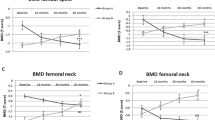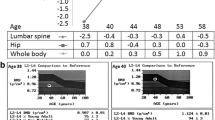Abstract
Patients with Cushing’s syndrome (CS) develop osteopenia-osteoporosis. The present study evaluates the recovery of bone mass within 2 years after remission of hypercortisolism and in long term follow up, an issue rarely addressed. Twenty patients (6M, 14F, 3 post-menopausal, 15–64 years old), 15 with Cushing’s disease, 2 with ectopic ACTH syndrome, 3 with ACTH-independent CS were studied. BMD, T and Z scores at lumbar spine and proximal femur were assessed by dual-energy X-ray absorptiometry before and 7–33 months after treatment of hypercortisolism. Five patients were treated with bisphosphonates. Four patients had hypogonadism and 4 GH-deficiency. At baseline all patients showed osteopenia/osteoporosis and the spine appeared more damaged than the femur; femur BMD was positively related with body mass index (BMI). No correlations were observed between spine and femur bone parameters and duration of disease or severity of hypercortisolism. Bone parameters did not differ in patients with or without GH or other pituitary deficiencies. After cure of hypercortisolism a significant improvement in spine BMD, Z and T scores and in femur Z and T scores was observed with normalization in 3 patients; there was no significant difference in percent improvement between femur and spine. The increase in bone parameters at spine and femur was independent from values at baseline. The percent increase in spine T and Z scores was positively related with time elapsed since cure. Bisphosphonates did not influence the recovery of bone mineralization. In long term follow up, after a median period of 7 years a further improvement in bone density was observed in 100% of patients at spine and in 9/11 at femur, although 8/11 patients still had femoral and/or vertebral T score in the range of osteopenia/osteoporosis. Spontaneous improvement of osteoporosis after cure of hypercortisolism occurs both at spine and femur, is independent from basal conditions and not affected by bisphosphonates. The improvement at spine depends on time since cure.


Similar content being viewed by others
References
Mancini T, Doga M, Mazziotti G, Giustina A (2004) Cushing’s syndrome and bone. Pituitary 7:249–252
Kaltsas G, Manetti L, Grossman AB (2002) Osteoporosis in Cushing’s syndrome. Front Horm Res 30:60–72
Manelli F, Giustina A (2000) Glucocorticoid-induced osteoporosis. Trends Endocrinol Metab 11:79–85
Osella G, Reimondo G, Peretti P, Ali A, Paccotti P, Angeli A, Terzolo M (2001) The patients with incidentally discovered adrenal adenoma (incidentaloma) are not at increased risk of osteoporosis. J Clin Endocrinol Metab 86:604–607
Vestergaard P, Lindholm J, Jorgensen JO, Hagen C, Hoeck HC, Laurberg P, Rejnmark L, Brixen K, Kristensen LO, Feldt-Rasmussen U, Mosekilde L (2002) Increased risk of osteoporotic fractures in patients with Cushing’s syndrome. Eur J Endocrinol 146:51–56
Arnaldi G, Angeli A, Atkinson AB, Bertagna X, Cavagnini F, Chrousos GP, Fava GA, Findling JW, Gaillard RC, Grossman AB, Kola B, Lacroix A, Mancini T, Mantero F, Newell-Price J, Nieman LK, Sonino N, Vance ML, Giustina A, Boscaro M (2003) Diagnosis and complications of Cushing’s syndrome: a consensus statement. J Clin Endocrinol Metab 88:5593–5602
Van Staa TP, Laan RF, Barton IP, Cohen S, Reid DM, Cooper C (2003) Bone density threshold and other predictors of vertebral fracture in patients receiving oral glucocorticoid therapy. Arthritis Rheum 48:3224–3229
Bonadonna S, Burattin A, Nuzzo M, Bugari G, Rosei EA, Valle D, Iori N, Bilezikian JP, Veldhuis JD, Giustina A (2005) Chronic glucocorticoid treatment alters spontaneous pulsatile parathyroid hormone secretory dynamics in human subjects. Eur J Endocrinol 152:199–205
Canalis E (1996) Clinical review 83: Mechanisms of glucocorticoid action in bone: implications to glucocorticoid-induced osteoporosis. J Clin Endocrinol Metab 81:3441–3447
Reid IR (2000) Glucocorticoid-induced osteoporosis. Baillieres Best Pract Res Clin Endocrinol Metab 14:279–298
Giustina A, Wehrenberg WB (1992) The role of glucocorticoids in the regulation of Growth Hormone secretion: mechanisms and clinical significance. Trends Endocrinol Metab 3:306–311
Delany AM, Durant D, Canalis E (2001) Glucocorticoid suppression of IGF I transcription in osteoblasts. Mol Endocrinol 15:1781–1789
Minetto M, Reimondo G, Osella G, Ventura M, Angeli A, Terzolo M (2004) Bone loss is more severe in primary adrenal than in pituitary-dependent Cushing’s syndrome. Osteoporos Int 15:855–861
Kristo C, Jemtland R, Ueland T, Godang K, Bollerslev J (2006) Restoration of the coupling process and normalization of bone mass following successful treatment of endogenous Cushing’s syndrome: a prospective, long-term study. Eur J Endocrinol 154:109–118
Hermus AR, Smals AG, Swinkels LM, Huysmans DA, Pieters GF, Sweep CF, Corstens FH, Kloppenborg PW (1995) Bone mineral density and bone turnover before and after surgical cure of Cushing’s syndrome. J Clin Endocrinol Metab 80:2859–2865
Catargi B, Tabarin A, Basse-Cathalinat B, Ducassou D, Roger P (1996) Development of bone mineral density after cure of Cushing’s syndrome]. Ann Endocrinol (Paris) 57:203–208
Kawamata A, Iihara M, Okamoto T, Obara T (2008) Bone mineral density before and after surgical cure of Cushing’s syndrome due to adrenocortical adenoma: prospective study. World J Surg 32:890–896
Manning PJ, Evans MC, Reid IR (1992) Normal bone mineral density following cure of Cushing’s syndrome. Clin Endocrinol (Oxf) 36:229–234
Luisetto G, Zangari M, Camozzi V, Boscaro M, Sonino N, Fallo F (2001) Recovery of bone mineral density after surgical cure, but not by ketoconazole treatment, in Cushing’s syndrome. Osteoporos Int 12:956–960
Genant HK, Jergas M, Palermo L, Nevitt M, Valentin RS, Black D, Cummings SR (1996) Comparison of semiquantitative visual and quantitative morphometric assessment of prevalent and incident vertebral fractures in osteoporosis The Study of Osteoporotic Fractures Research Group. J Bone Miner Res 11:984–996
Stazi AV, Manno V, Torre M (2009) Osteoporosi: cause, prevenzione, terapie e dati epidemiologici. Notiziario dell’istituto superiore di sanità 22(12): 3–8. http://www.iss.it/binary/cont/NotiziarioDicembre_2009.pdf. Accessed 27 December 2010
World Health Organization Scientific Group on the Prevention and Management of Osteoporosis (2000) Prevention and management of osteoporosis: report of a WHO scientific group. WHO technical report series n. 921
Albala C, Yanez M, Devoto E, Sostin C, Zeballos L, Santos JL (1996) Obesity as a protective factor for postmenopausal osteoporosis. Int J Obes Relat Metab Disord 20:1027–1032
Greco EA, Fornari R, Rossi F, Santiemma V, Prossomariti G, Annoscia C, Aversa A, Brama M, Marini M, Donini LM, Spera G, Lenzi A, Lubrano C, Migliaccio S (2010) Is obesity protective for osteoporosis? Evaluation of bone mineral density in individuals with high body mass index. Int J Clin Pract 64:817–820
De Laet C, Kanis JA, Oden A, Johanson H, Johnell O, Delmas P, Eisman JA, Kroger H, Fujiwara S, Garnero P, McCloskey EV, Mellstrom D, Melton LJ 3rd, Meunier PJ, Pols HA, Reeve J, Silman A, Tenenhouse A (2005) Body mass index as a predictor of fracture risk: a meta-analysis. Osteoporos Int 16:1330–1338
Shapses SA, Riedt CS (2006) Bone, body weight, and weight reduction: what are the concerns? J Nutr 136:1453–1456
Tauchmanova L, Pivonello R, De Martino MC, Rusciano A, De Leo M, Ruosi C, Mainolfi C, Lombardi G, Salvatore M, Colao A (2007) Effects of sex steroids on bone in women with subclinical or overt endogenous hypercortisolism. Eur J Endocrinol 157:359–366
Weaver JU, Thaventhiran L, Noonan K, Burrin JM, Taylor NF, Norman MR, Monson JP (1994) The effect of growth hormone replacement on cortisol metabolism and glucocorticoid sensitivity in hypopituitary adults. Clin Endocrinol (Oxf) 41:639–648
Giustina A, Mazziotti G, Canalis E (2008) Growth hormone, insulin-like growth factors, and the skeleton. Endocr Rev 29:535–559
Faggiano A, Pivonello R, Filippella M, Di Somma C, Orio F Jr, Lombard G, Colao A (2001) Spine abnormalities and damage in patients cured from Cushing’s disease. Pituitary 4:153–161
Chiodini I, Carnevale V, Torlontano M, Fusilli S, Guglielmi G, Pileri M, Modoni S, Di Giorgio A, Liuzzi A, Minisola S, Cammisa M, Trischitta V, Scillitani A (1998) Alterations of bone turnover and bone mass at different skeletal sites due to pure glucocorticoid excess: study in eumenorrheic patients with Cushing’s syndrome. J Clin Endocrinol Metab 83:1863–1867
Tauchmanova L, Pivonello R, Di Somma C, Rossi R, De Martino MC, Camera L, Klain M, Salvatore M, Lombardi G, Colao A (2006) Bone demineralization and vertebral fractures in endogenous cortisol excess: role of disease etiology and gonadal status. J Clin Endocrinol Metab 91:1779–1784
Compston J (2004) US and UK guidelines for glucocorticoid-induced osteoporosis: similarities and differences. Curr Rheumatol Rep 6:66–69
Adachi JD, Bensen WG, Brown J, Hanley D, Hodsman A, Josse R, Kendler DL, Lentle B, Olszynski W, Ste-Marie LG, Tenenhouse A, Chines AA (1997) Intermittent etidronate therapy to prevent corticosteroid-induced osteoporosis. N Engl J Med 337:382–387
Saag KG, Emkey R, Schnitzer TJ, Brown JP, Hawkins F, Goemaere S, Thamsborg G, Liberman UA, Delmas PD, Malice MP, Czachur M, Daifotis AG (1998) Alendronate for the prevention and treatment of glucocorticoid-induced osteoporosis. Glucocorticoid-Induced Osteoporosis Intervention Study Group. N Engl J Med 339:292–299
Tauchmanova L, Guerra E, Pivonello R, De Martino MC, De Leo M, Caggiano F, Lombardi G, Colao A (2009) Weekly clodronate treatment prevents bone loss and vertebral fractures in women with subclinical Cushing’s syndrome. J Endocrinol Invest 32:390–394
Di Somma C, Colao A, Pivonello R, Klain M, Faggiano A, Tripodi FS, Merola B, Salvatore M, Lombardi G (1998) Effectiveness of chronic treatment with alendronate in the osteoporosis of Cushing’s disease. Clin Endocrinol (Oxf) 48:655–662
Plotkin LI, Bivi N, Bellido T (2010) A bisphosphonate that does not affect osteoclasts prevents osteoblast and osteocyte apoptosis and the loss of bone strength induced by glucocorticoids in mice. Bone
Author information
Authors and Affiliations
Corresponding author
Rights and permissions
About this article
Cite this article
Randazzo, M.E., Grossrubatscher, E., Dalino Ciaramella, P. et al. Spontaneous recovery of bone mass after cure of endogenous hypercortisolism. Pituitary 15, 193–201 (2012). https://doi.org/10.1007/s11102-011-0306-3
Published:
Issue Date:
DOI: https://doi.org/10.1007/s11102-011-0306-3




